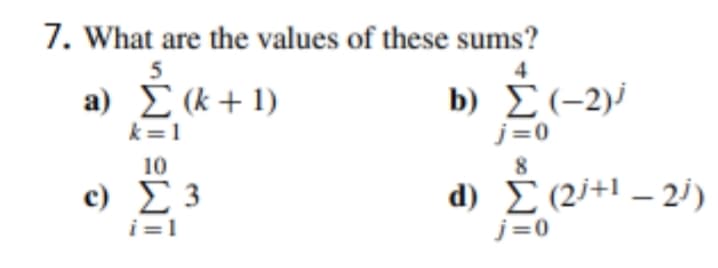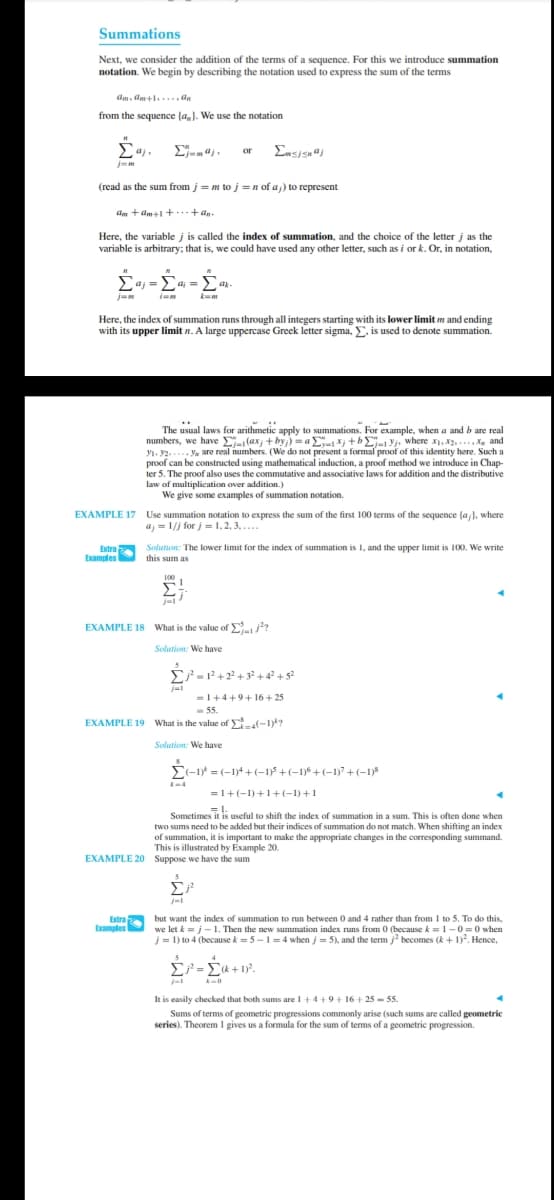Algebra & Trigonometry with Analytic Geometry
13th Edition
ISBN:9781133382119
Author:Swokowski
Publisher:Swokowski
Chapter10: Sequences, Series, And Probability
Section: Chapter Questions
Problem 50RE
Related questions
Question

Transcribed Image Text:7. What are the values of these sums?
4
a) Σα+1)
b) Σ-2))
j=0
k=1
10
8
c) E 3
d) E (2j+1 – 2i)
i=1
j=0

Transcribed Image Text:Summations
Next, we consider the addition of the terms of a sequence. For this we introduce summation
notation. We begin by describing the notation used to express the sum of the terms
am. dm+l.... dn
from the sequence (a,). We use the notation
Easisa@j
or
(read as the sum from j = m to j =n of a ) to represent
am + am+1 +...+ an.
Here, the variable j is called the index of summation, and the choice of the letter j as the
variable is arbitrary: that is, we could have used any other letter, such as i or k. Or, in notation,
Here, the index of summation runs through all integers starting with its lower limit m and ending
with its upper limit n. A large uppercase Greek letter sigma, E, is used to denote summation.
The usual laws for arithmetic apply to summations. For example, when a and b are real
numbers, we have E-(ax; + by) = a E- j +bE-Yj, where x, X2, ..., X, and
y1. 2..... Ya are real numbers. (We do not present a formal proof of this identity here. Such a
proof can be constructed using mathematical induction, a proof method we introduce in Chap-
ter 5. The proof also uses the commutative and associative laws for addition and the distributive
law of multiplication over addition.)
We give some examples of summation notation.
EXAMPLE 17 Use summation notation to express the sum of the first 100 terms of the sequence (a,}, where
a = 1/j for j = 1, 2, 3. ....
Extra
Examples
Solution: The lower limit for the index of summation is 1, and the upper limit is 100. We write
this sum as
100
EXAMPLE 18 What is the value of E-?
Solution: We have
E-+2+ 3²+ 4² + 5²
=I+4+9+ 16+ 25
- 55.
EXAMPLE 19 What is the value of -1)?
Solution: We have
(-1)* = (-1)4 + (-1) +(-1)* +(-1)7 +(-1)
=1+(-1) +1+(-1) +1
Sometimes it is useful to shift the index of summation in a sum. This is often done when
two sums need to be added but their indices of summation do not match. When shifting an index
of summation, it is important to make the appropriate changes in the corresponding summand.
This is illustrated by Example 20.
EXAMPLE 20 Suppose we have the sum
Extra
but want the index of summation to run between 0 and 4 rather than from I to 5. To do this,
Examples we let k = j -1. Then the new summation index runs from 0 (because k = 1-0=0 when
j = 1) to 4 (because k = 5-1= 4 when j= 5), and the term j becomes (k +
.Hence,
EP =Ek + 1).
It is easily checked that both sums are I+4+9+ 16 + 25 - 55.
Sums of terms of geometric progressions commonly arise (such sums are called geometric
series). Theorem I gives us a formula for the sum of terms of a geometrie progression.
Expert Solution
This question has been solved!
Explore an expertly crafted, step-by-step solution for a thorough understanding of key concepts.
This is a popular solution!
Trending now
This is a popular solution!
Step by step
Solved in 2 steps with 2 images

Knowledge Booster
Learn more about
Need a deep-dive on the concept behind this application? Look no further. Learn more about this topic, calculus and related others by exploring similar questions and additional content below.Recommended textbooks for you

Algebra & Trigonometry with Analytic Geometry
Algebra
ISBN:
9781133382119
Author:
Swokowski
Publisher:
Cengage


Elementary Geometry For College Students, 7e
Geometry
ISBN:
9781337614085
Author:
Alexander, Daniel C.; Koeberlein, Geralyn M.
Publisher:
Cengage,

Algebra & Trigonometry with Analytic Geometry
Algebra
ISBN:
9781133382119
Author:
Swokowski
Publisher:
Cengage


Elementary Geometry For College Students, 7e
Geometry
ISBN:
9781337614085
Author:
Alexander, Daniel C.; Koeberlein, Geralyn M.
Publisher:
Cengage,